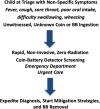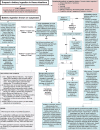Current management of button battery injuries
- PMID: 34195377
- PMCID: PMC8223456
- DOI: 10.1002/lio2.535
Current management of button battery injuries
Abstract
Button batteries (BB) are found in common household items and can lead to significant morbidity and mortality in the pediatric population when ingested. BBs are made of various chemistries and have a unique size and shape that yield significant injury when lodged in the pediatric esophagus. BBs create a local tissue pH environment of 10 to 13 and can induce liquefactive necrosis at the negative pole. This initial injury can progress with further tissue breakdown even after removal. Unfortunately, patients may present with vague symptoms similar to viral illnesses and there is not always a known history of ingestion. Plain film X-ray can be diagnostic. Exposure can lead to caustic injury within 2 hours. Thus, timely endoscopic removal is the mainstay of treatment. Novel mitigation and neutralization strategies have been implemented into treatment guidelines. These include the preremoval ingestion of honey or sucralfate and intraoperative irrigation with acetic acid. Depending on the severity of injury following removal, careful consideration should be given for potential delayed complications including fistulization into major vessels which often leads to death. The National Button Battery Taskforce and several industry members have implemented prevention strategies such as educational safety outreach campaigns, child-resistant packaging changes, and warning labels. Governmental regulation and industry changes are key to limit not only the amount of BB ingestions, but also the devastating consequences that can result. Anonymous reporting of BB injuries through the Global Injury Research Collaborative has been made convenient and centralized through the advent of a user-friendly smartphone iOS/App Store and Android/GooglePlay application called the "GIRC App"; all specialists who manage foreign body cases should contribute their cases to help prevent future injuries. BB ingestion must be recognized and treated promptly using a multidisciplinary approach to optimize outcomes for these patients. Ultimately, a safer BB technology is critically needed to reduce or eliminate the severe and life-threatening injuries in children.
Level of evidence: 5.
Keywords: battery injury; button battery; disc battery; esophageal foreign body; pediatric injury.
© 2021 The Authors. Laryngoscope Investigative Otolaryngology published by Wiley Periodicals LLC on behalf of The Triological Society.
Conflict of interest statement
Kris R. Jatana serves as a general product safety medical consultant for Intertek Inc. Kris R. Jatana has a patent pending coin/battery metal detector device under development and receives royalties for a patented, commercially available medical device, not related to nor discussed in this article from Marpac Inc. Kris R. Jatana is a shareholder in Zotarix LLC, Landsdowne Labs LLC, and Tivic Health Systems. Kris R. Jatana serves in leadership positions on the National Button Battery Task Force, supported by and affiliated with the American Academy of Pediatrics and American Broncho‐Esophagological Association. Kris R. Jatana and Keith Rhoades are advisory board members of the Global Injury Research Collaborative which is a U.S. IRS‐designated, 501(c)(3) nonprofit organization. This article is for educational use only, and the content is based on review of available resources to the authors on this topic. The content does not necessarily represent the opinions of any of the institutions or organizations authors are affiliated with.
Figures









References
-
- Gibbs H, Rhoades K, Jatana KR. Management of pediatric button battery injuries from ingestion, aspiration, and insertion in the urgent care and emergency room setting. Clin Pediatr Emerg Med. In Press. 2020;21(2). 10.1016/j.cpem.2020.100775. - DOI
-
- allaboutbatteries.com . History of Battery Invention and Development. 2011. http://www.allaboutbatteries.com/history-of-batteries.html. Accessed October 20, 2020.
-
- Poison Control Center . Battery Ingestion Hotline. 2020. https://www.batteryingestionhotline.com/. Accessed October 19, 2020.
-
- Consumer Product Safety Commission . CPSC Issues Warning On Button Batteries. 1983. https://www.cpsc.gov/Newsroom/News‐Releases/1983/CPSC‐Issues‐Warning‐On‐.... Accessed October 21, 2020.
Publication types
LinkOut - more resources
Full Text Sources
Research Materials
